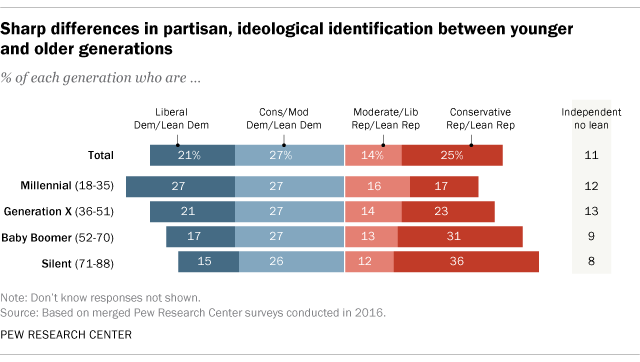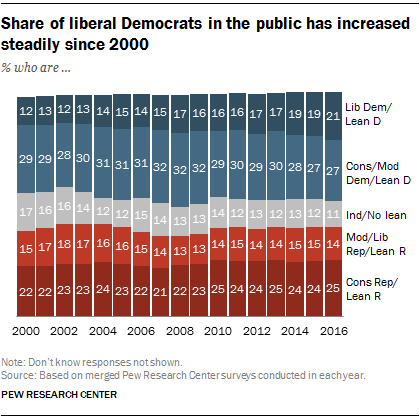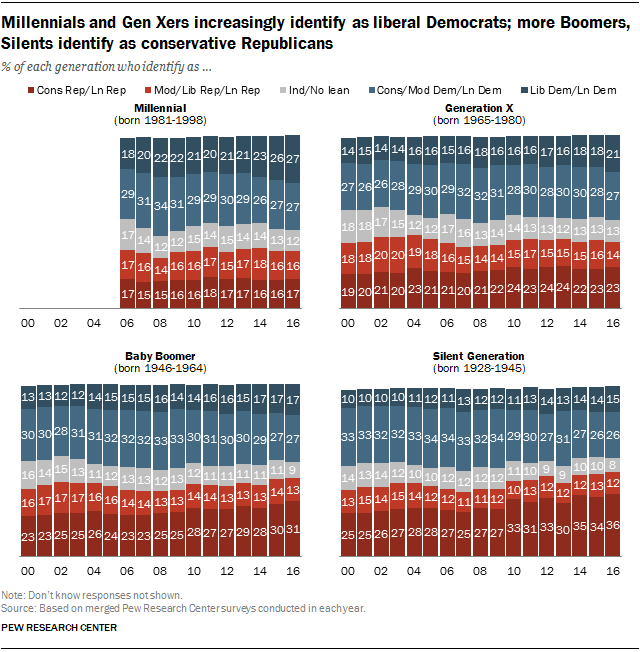Average Citizens Who Register As Party Members Would Be Classified Under Which Category?
The generation gap in American politics is dividing ii younger age groups, Millennials and Generation X, from the two older groups, Baby Boomers and the Silent Generation.
In 2016, as in recent years, Millennials and Gen Xers were the most Autonomous generations. And both groups had relatively large – and growing – shares of liberal Democrats: 27% of Millennials and 21% of Gen Xers identified as liberal Democrats or Autonomous-leaning independents.
 Past contrast, Boomers and Silents were the most Republican groups – largely because of the higher shares of conservative Republicans in these generations. Nearly a third of Boomers (31%) and 36% of Silents described themselves equally conservative Republicans or Republican leaners, which also is higher than in the past.
Past contrast, Boomers and Silents were the most Republican groups – largely because of the higher shares of conservative Republicans in these generations. Nearly a third of Boomers (31%) and 36% of Silents described themselves equally conservative Republicans or Republican leaners, which also is higher than in the past.
 The differences in partisan identification across generations are nigh apparent in the shares of liberal Democrats and bourgeois Republicans in each. All 4 groups have comparable numbers when it comes to groups in the middle: bourgeois and moderate Democrats and moderate and liberal Republicans.
The differences in partisan identification across generations are nigh apparent in the shares of liberal Democrats and bourgeois Republicans in each. All 4 groups have comparable numbers when it comes to groups in the middle: bourgeois and moderate Democrats and moderate and liberal Republicans.
The public'due south overall partisan and ideological rest changes niggling from yr to yr. Merely at that place take been some long-term shifts amongst the public and within generational groups, according to a new analysis based on more 15,000 interviews conducted in 2016 equally well equally before survey information. (For a wait at trends among registered voters, see "The Parties on the Eve of the 2016 Election: Two Coalitions, Moving Further Apart.")
The share of liberal Democrats in the public has grown. In 2016, 21% of Americans identified as Democrats or Democratic leaners and also equally liberal. While that is just somewhat higher than a yr earlier (nineteen%), information technology is the highest share dating dorsum to 2000. At that time, only 12% of the public described themselves equally both liberal and as Democrats or Democratic leaners.
At that place has been little change since 2000 in other partisan and ideological categories, although the share proverb they do not lean to either party is smaller today (11%) than in the early 2000s (17% in 2000).
Millennials were most likely to identify as liberal Democrats. In 2016, a majority of Millennials (55%) identified as Democrats or leaned Democratic; 27% described themselves as liberal Democrats – the highest share of whatever generation. For much of the past decade, conservative and moderate Democrats outnumbered liberal Democrats amid Millennials. But in the past few years, in that location were about as many liberal Democrats as conservative and moderate Democrats among this youngest adult historic period grouping (those who were 18 to 35 in 2016).
 The share of liberal Democrats in Gen X ticked up. As in recent years, conservative and moderate Democrats made up the largest partisan and ideological group among Gen Xers (27%), who were ages 36 to 51 concluding year. However, the share of Gen Xers who identified every bit liberal Democrats (21%) stood at its highest indicate since 2000. About as many Gen Xers (23%) described themselves as conservative Republicans, a figure that has not changed much in recent years.
The share of liberal Democrats in Gen X ticked up. As in recent years, conservative and moderate Democrats made up the largest partisan and ideological group among Gen Xers (27%), who were ages 36 to 51 concluding year. However, the share of Gen Xers who identified every bit liberal Democrats (21%) stood at its highest indicate since 2000. About as many Gen Xers (23%) described themselves as conservative Republicans, a figure that has not changed much in recent years.
Boomers have turned more bourgeois. In both 2015 and 2016, near iii-in-ten Boomers (30% in 2015, 31% in 2016) identified as conservative Republicans – the highest percentages dating back to 2000. In both years, bourgeois Republicans made upward the largest single partisan and ideological group among Boomers.
Members of the Silent Generation continued to be most likely to identify as conservative Republicans. The GOP has made large gains amidst Silents in recent years. Eight years agone, Democrats and Democratic leaners outnumbered Republicans and GOP leaners among Silents by 48% to forty%; in 2016, 49% of Silents identified as Republicans or leaned Republican, while 43% leaned Democratic. The share of Silents who describe themselves as conservative Republicans increased by 9 per centum points over this flow, from 27% to 36%.
Shiva Maniam is a former research assistant who focused on U.S. politics and policy research at Pew Inquiry Heart.
Samantha Smith is a onetime research assistant at Pew Research Center.
Average Citizens Who Register As Party Members Would Be Classified Under Which Category?,
Source: https://www.pewresearch.org/fact-tank/2017/03/20/a-wider-partisan-and-ideological-gap-between-younger-older-generations/
Posted by: eadieeavelifire.blogspot.com


0 Response to "Average Citizens Who Register As Party Members Would Be Classified Under Which Category?"
Post a Comment